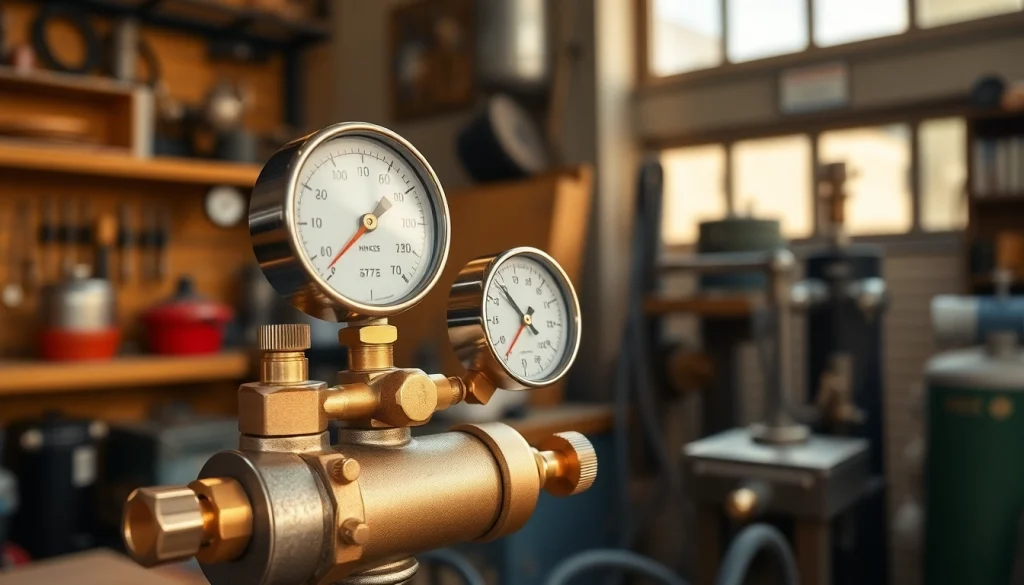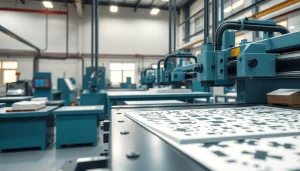Essential Guide to Choosing the Right Nitrogen Regulator for Your Needs

Understanding Nitrogen Regulators
Nitrogen regulators are essential devices that help manage the pressure of nitrogen gas, ensuring its safe and effective use across various applications. As industries increasingly rely on nitrogen for multiple processes, understanding how nitrogen regulators operate becomes vital. Whether you’re in HVAC, food and beverage processing, or any industrial application, a precise nitrogen regulator can enhance safety, efficiency, and consistency.
What is a Nitrogen Regulator?
A nitrogen regulator is a device that controls the pressure and flow of nitrogen gas from a cylinder to various applications. It ensures that the pressure of the nitrogen is reduced from high cylinder pressure to a lower, usable level. This allows professionals to use nitrogen for tasks such as purging systems, pressurizing equipment, and enhancing product quality.
Key Components of Nitrogen Regulators
Understanding the components of nitrogen regulators can enhance their effective utilization. The key components include:
- Pressure Gauge: Displays the pressure of the nitrogen gas. It helps users monitor performance and ensure safe operating levels.
- Adjustable Outlet Valve: This valve allows users to set the desired outlet pressure, providing flexibility depending on the task requirements.
- Cylinder Connection: The part that connects the regulator to the nitrogen cylinder. This is usually a CGA fitting suitable for specific gas types.
- Body Housing: The main structure that contains all the internal components and protects them from external damage.
- Diaphragm: An essential part that senses the pressure changes and adjusts the valve opening accordingly.
How Nitrogen Regulators Work
Nitrogen regulators function by controlling the pressure of nitrogen gas released from a cylinder. When the nitrogen is released, it enters the regulator, where it encounters the diaphragm. As pressure builds, the diaphragm flexes, causing the outlet valve to open or close, depending on the set pressure. This continuous process ensures that the outlet pressure remains stable and at the desired level.
Types of Nitrogen Regulators
There are various types of nitrogen regulators, each tailored to specific applications. The choice of regulator can influence both performance and safety, hence it is vital to understand the available options.
Single vs. Dual Outlet Nitrogen Regulators
Nitrogen regulators come in two primary configurations: single outlet and dual outlet. Single outlet regulators are designed for applications that require only one source of nitrogen flow, while dual outlet regulators can distribute nitrogen to multiple applications simultaneously. The choice depends on the complexity of the tasks at hand. For instance, in environments like brewing, a dual outlet regulator allows simultaneous dispensing, improving efficiency.
Adjustable vs. Preset Pressure Regulators
Adjustable pressure regulators allow users to manually set the output pressure as per the requirement, providing greater flexibility. In contrast, preset pressure regulators come with fixed pressure settings, making them simpler to use but less versatile. Adjustable regulators are often preferred in processes requiring precise control, such as in nitrogen purging or pressure testing.
Choosing Between High Pressure and Low Pressure Regulators
A critical decision in selecting a nitrogen regulator is understanding when to use high pressure versus low pressure models. High-pressure regulators are often needed for industrial applications requiring high flow rates, while low-pressure regulators suit less demanding situations, such as food preservation. Understanding the specific needs of your application helps ensure safety and efficiency.
Applications of Nitrogen Regulators
The applications for nitrogen regulators are diverse, spanning numerous industries. Here are some key areas where they play a vital role:
Use in HVAC Systems
Nitrogen is frequently used in HVAC systems for pressure testing. By using nitrogen regulators, technicians can safely pressurize systems to detect leaks without risking contamination from moisture or oxygen. The precise control offered by these regulators facilitates effective maintenance and ensures the longevity of systems.
Industrial Applications
In industrial settings, nitrogen regulators are indispensable for processes such as metal manufacturing, laser cutting, and chemical production. They help ensure that nitrogen is delivered at the required pressure and flow rates, enhancing operational efficiency and product quality. Additionally, nitrogen’s inert characteristics make it ideal for protecting materials from oxidation during manufacturing processes.
Nitrogen Regulators in Food and Beverage Industry
In the food and beverage sector, nitrogen is used to preserve the quality and freshness of products. Nitrogen regulators help control the atmosphere within storage and packaging systems. This prolongs shelf life and maintains flavor and quality. For example, breweries utilize nitrogen regulators to pressurize kegs, enhancing the carbonation process and improving the overall taste profile.
Benefits of Using a Nitrogen Regulator
Investing in a high-quality nitrogen regulator provides numerous advantages across various applications. These benefits include:
Improved Safety and Control
One of the primary advantages of using nitrogen regulators is enhanced safety. With the ability to precisely control outlet pressure, operators can eliminate the risk of over-pressurizing systems, which may lead to accidents and equipment damage. This control is essential in industries where high-pressure operations are routine, such as welding and chemical processing.
Consistent Performance
Nitrogen regulators ensure that systems operate reliably and consistently. By maintaining steady pressure, these regulators help to avoid fluctuations that can affect performance quality. This is particularly crucial in food production, HVAC systems, and industrial applications, where quality consistency is key to success.
Cost Efficiency Over Time
While nitrogen regulators represent an upfront investment, their long-term benefits can lead to significant cost savings. By ensuring efficient nitrogen use and reducing waste, operations can decrease expenses related to nitrogen procurement. Moreover, with enhanced safety and performance, businesses can avoid costly downtime and repairs.
Maintenance and Troubleshooting Tips
Proper maintenance is essential for prolonging the life of nitrogen regulators and ensuring they operate within safe parameters. By following a few simple guidelines, users can ensure optimal functioning.
Regular Maintenance Practices
To keep nitrogen regulators in top condition, regular maintenance practices should include:
- Inspecting connections for leaks regularly.
- Cleaning the regulator’s exterior to prevent contamination.
- Checking pressure gauges for accuracy.
- Replacing seals and O-rings as needed to avoid leaks.
Common Issues and Solutions
Users may encounter several common issues with nitrogen regulators, such as fluctuating pressure or leaks. Troubleshooting these issues involves:
- Identifying leaks by applying soapy water to connections and monitoring for bubbles.
- Checking for blockages in the outlet to ensure smooth flow.
- Adjusting the regulator settings if pressure fluctuations occur.
When to Replace Your Nitrogen Regulator
Knowing when to replace a nitrogen regulator can prevent safety hazards and ensure operational efficiency. Signs that a regulator may need replacing include:
- Frequent leaks despite regular maintenance.
- Inaccurate pressure readings on the gauge.
- Physical damage to the regulator body or components.
In conclusion, understanding the mechanisms and applications of nitrogen regulators is pivotal for anyone involved in industries utilizing nitrogen gas. By selecting the right type of regulator and maintaining it properly, users can enhance safety, efficiency, and performance in various operations.







